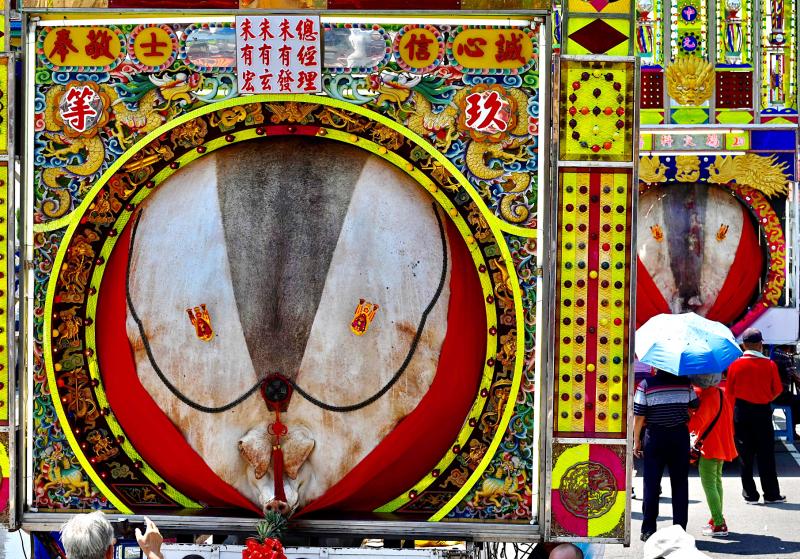A festival where enormous pigs are slaughtered and displayed is drawing smaller crowds as animal rights activists alter perceptions of the controversial tradition.
The annual ritual is a cultural cornerstone for the nation’s Hakka community, who make up about 15 percent of the population. But it has long been a polarizing custom.
Local Hakka families compete to display the largest pig, with the winner taking home a trophy.

Photo: AFP
To a fanfare of traditional music played on gongs and horns, 18 slaughtered pigs were wheeled out on trucks Monday into the Hsinpu Yimin Temple in Hsinchu County .
The heaviest weighed a whopping 860kg — three times the average adult swine. The carcasses, bristles shaved and pinned with decorations, were displayed upside-down, the heads with pineapples stuffed in their mouths, dwarfed by their bloated torsos.
After the festival, the carcasses are taken home by their owners and the meat distributed to friends, family and neighbors.

Photo: AFP
Tseng Jia-yun’s family spent three years fattening up their pig, which was slaughtered last week weighing 400kg.
The sacrifice fulfilled the wishes of his 86-year-old grandmother.
“As a Hakka, I am proud of this divine pig culture, it’s worth preserving,” he said, describing the concerns of animal rights groups as “nonsense.”
“There’s no cruelty to animals, contrary to the rumors being spread around,” he added.
OUTDATED RITUAL?
Animal rights campaigners disagree.
They say the heaviest pigs are force fed, often in small cages to the point where the morbidly obese animals are unable to get up.
The pigs are so heavy that they can’t even stand,” said Lin Tai-ching (林岱瑾), director of the Environment and Animal Society of Taiwan.
Lin has been documenting the “holy pig” festival for the last 15 years and says attitudes are beginning to change.
Crowds have begun to thin and the number of sacrifices has fallen dramatically.
“Fifteen years ago there were more than 100 swine in the contest, compared to 37 this year,” she said.
The number of animals over 600kg had also plummeted, she added.
Two submissions this year were made up of rice packets displayed in the shape of a pig, a sign that some participating families are rejecting animal sacrifices.
Researchers and locals say that while the festival dates back centuries, the tradition of sacrificing fattened pigs is a more recent phenomenon.
The Hakka are one of the many ethnic groups from China who settled in Taiwan over the last few hundred years. Each summer the Hsinpu Yimin Temple commemorates a group of Hakka who died defending their villages during a period of political upheaval in the late eighteenth century.
However, it was during Japan’s colonial occupation of Taiwan in the early twentieth century that the sacrificing of fattened pigs became a commonplace part of the celebrations. The custom then became turbocharged in the 1980s and 1990s with the pigs getting bigger and bigger.
“The Yimin festival is to honor our ancestors who died defending our homeland, a display of loyalty and brotherhood,” Tseng said.
Lin and other animal rights activists say they have no desire to end Hakka cultural customs. Instead they want to see the festival’s more cruel elements tamed. “We are not against the sacrifice of pigs,” she said, “but we are against competitions based on an animal’s weight.”

This is the year that the demographic crisis will begin to impact people’s lives. This will create pressures on treatment and hiring of foreigners. Regardless of whatever technological breakthroughs happen, the real value will come from digesting and productively applying existing technologies in new and creative ways. INTRODUCING BASIC SERVICES BREAKDOWNS At some point soon, we will begin to witness a breakdown in basic services. Initially, it will be limited and sporadic, but the frequency and newsworthiness of the incidents will only continue to accelerate dramatically in the coming years. Here in central Taiwan, many basic services are severely understaffed, and

Jan. 5 to Jan. 11 Of the more than 3,000km of sugar railway that once criss-crossed central and southern Taiwan, just 16.1km remain in operation today. By the time Dafydd Fell began photographing the network in earnest in 1994, it was already well past its heyday. The system had been significantly cut back, leaving behind abandoned stations, rusting rolling stock and crumbling facilities. This reduction continued during the five years of his documentation, adding urgency to his task. As passenger services had already ceased by then, Fell had to wait for the sugarcane harvest season each year, which typically ran from

It is a soulful folk song, filled with feeling and history: A love-stricken young man tells God about his hopes and dreams of happiness. Generations of Uighurs, the Turkic ethnic minority in China’s Xinjiang region, have played it at parties and weddings. But today, if they download it, play it or share it online, they risk ending up in prison. Besh pede, a popular Uighur folk ballad, is among dozens of Uighur-language songs that have been deemed “problematic” by Xinjiang authorities, according to a recording of a meeting held by police and other local officials in the historic city of Kashgar in

The People’s Republic of China (PRC) was out in force in the Taiwan Strait this week, threatening Taiwan with live-fire exercises, aircraft incursions and tedious claims to ownership. The reaction to the PRC’s blockade and decapitation strike exercises offer numerous lessons, if only we are willing to be taught. Reading the commentary on PRC behavior is like reading Bible interpretation across a range of Christian denominations: the text is recast to mean what the interpreter wants it to mean. Many PRC believers contended that the drills, obviously scheduled in advance, were aimed at the recent arms offer to Taiwan by the